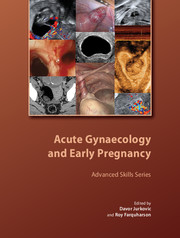32 results
Chapter 3B - Holistic Assessment in Pediatric and Adolescent Gynecology Practice
-
-
- Book:
- Pediatric and Adolescent Gynecology
- Published online:
- 01 February 2018
- Print publication:
- 08 February 2018, pp 21-30
-
- Chapter
- Export citation
10 - The Use of 3D Ultrasound and Colour Doppler in Early Pregnancy
-
-
- Book:
- Early Pregnancy Ultrasound
- Published online:
- 20 October 2017
- Print publication:
- 14 September 2017, pp 75-81
-
- Chapter
- Export citation
7 - Nontubal Ectopic Pregnancy
-
-
- Book:
- Early Pregnancy Ultrasound
- Published online:
- 20 October 2017
- Print publication:
- 14 September 2017, pp 50-58
-
- Chapter
- Export citation
19 - Non-Tubal Ectopic Pregnancy
-
-
- Book:
- Early Pregnancy
- Published online:
- 16 February 2017
- Print publication:
- 02 February 2017, pp 187-195
-
- Chapter
- Export citation
Contributors
-
-
- Book:
- Pregnancy After Assisted Reproductive Technology
- Published online:
- 05 October 2012
- Print publication:
- 06 September 2012, pp viii-x
-
- Chapter
- Export citation
Chapter 3 - The role of ultrasound in early pregnancy after assisted conception
-
-
- Book:
- Pregnancy After Assisted Reproductive Technology
- Published online:
- 05 October 2012
- Print publication:
- 06 September 2012, pp 14-35
-
- Chapter
- Export citation
Acknowledgements
-
- Book:
- Acute Gynaecology and Early Pregnancy
- Published online:
- 05 July 2014
- Print publication:
- 01 March 2011, pp x-x
-
- Chapter
- Export citation
3 - Diagnosis of miscarriage
-
-
- Book:
- Acute Gynaecology and Early Pregnancy
- Published online:
- 05 July 2014
- Print publication:
- 01 March 2011, pp 23-36
-
- Chapter
- Export citation
4 - Conservative and surgical management of miscarriage
-
-
- Book:
- Acute Gynaecology and Early Pregnancy
- Published online:
- 05 July 2014
- Print publication:
- 01 March 2011, pp 37-48
-
- Chapter
- Export citation
Preface
-
- Book:
- Acute Gynaecology and Early Pregnancy
- Published online:
- 05 July 2014
- Print publication:
- 01 March 2011, pp xiii-xiv
-
- Chapter
- Export citation
Abbreviations
-
- Book:
- Acute Gynaecology and Early Pregnancy
- Published online:
- 05 July 2014
- Print publication:
- 01 March 2011, pp xi-xii
-
- Chapter
- Export citation

Acute Gynaecology and Early Pregnancy
-
- Published online:
- 05 July 2014
- Print publication:
- 01 March 2011
Index
-
- Book:
- Acute Gynaecology and Early Pregnancy
- Published online:
- 05 July 2014
- Print publication:
- 01 March 2011, pp 233-241
-
- Chapter
- Export citation
Contents
-
- Book:
- Acute Gynaecology and Early Pregnancy
- Published online:
- 05 July 2014
- Print publication:
- 01 March 2011, pp v-vi
-
- Chapter
- Export citation
Frontmatter
-
- Book:
- Acute Gynaecology and Early Pregnancy
- Published online:
- 05 July 2014
- Print publication:
- 01 March 2011, pp i-iv
-
- Chapter
- Export citation
12 - Diagnosis and management of non-tubal ectopic pregnancy
-
-
- Book:
- Acute Gynaecology and Early Pregnancy
- Published online:
- 05 July 2014
- Print publication:
- 01 March 2011, pp 151-168
-
- Chapter
- Export citation
About the authors
-
- Book:
- Acute Gynaecology and Early Pregnancy
- Published online:
- 05 July 2014
- Print publication:
- 01 March 2011, pp vii-ix
-
- Chapter
- Export citation
Contributors
-
-
- Book:
- Early Pregnancy
- Published online:
- 05 October 2010
- Print publication:
- 09 September 2010, pp vii-x
-
- Chapter
- Export citation
Chapter 4 - Ultrasound detection of congenital uterine anomalies
-
-
- Book:
- Early Pregnancy
- Published online:
- 05 October 2010
- Print publication:
- 09 September 2010, pp 29-38
-
- Chapter
- Export citation
4 - Postmenopausal bleeding: presentation and investigation
-
-
- Book:
- Gynaecological Ultrasound in Clinical Practice
- Published online:
- 05 February 2014
- Print publication:
- 01 June 2009, pp 29-42
-
- Chapter
- Export citation



